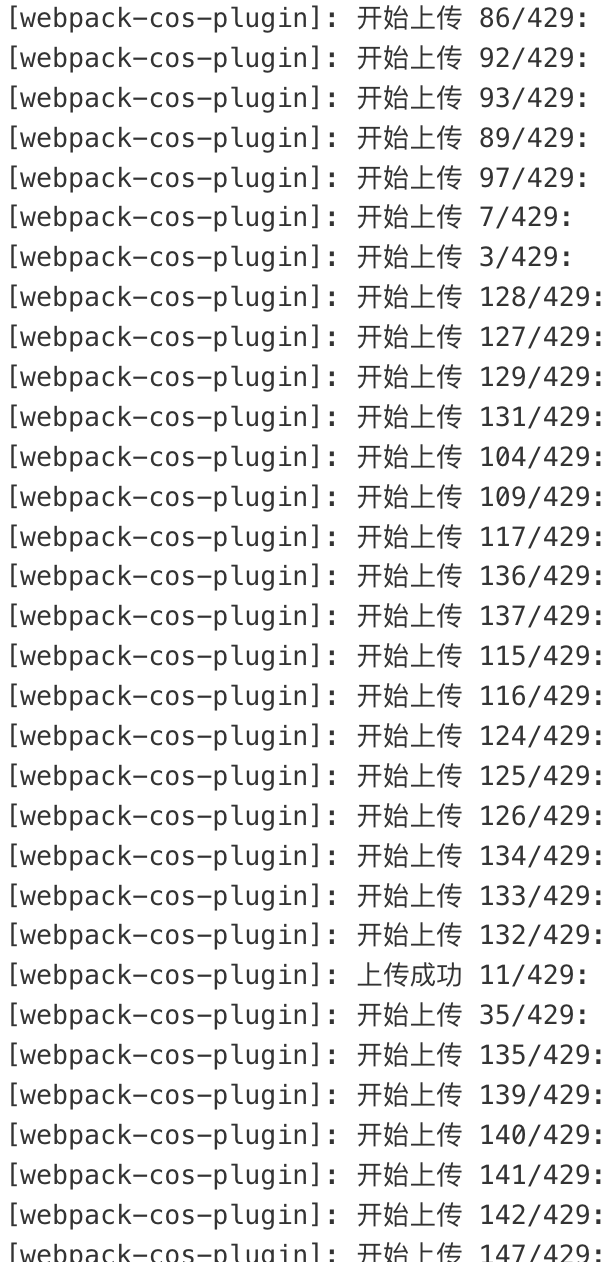前言
最近发现前端框架页面加载非常的慢,为了解决这个问题,项目组决定将webpacke打包后的文件部署到腾讯COS上面,这样可以提高加载速度。
准备
我们的前端框架使用的是vue.js2.0 + vue-cli大家可以根据自己的环境进行调整,下面是具体的操作。
操作
1、添加依赖包
"webpack-cos-plugin-qapm": "^1.2.0"
"scripts": {
"serve": "vue-cli-service serve",
"serve-local": "vue-cli-service serve --mode local",
"build": "vue-cli-service build --mode staging",
"build:stage": "vue-cli-service build --mode staging",
"build:production": "vue-cli-service build --mode production",
"build:uat": "vue-cli-service build --mode uat",
"build:prod": "vue-cli-service build --mode production",
"build:report": "vue-cli-service build --report",
"preview": "node build/index.js --preview",
"lint": "eslint --ext .js,.vue src/",
"lint-fix": "eslint --fix --ext .js,.vue src/",
"lint:report": "npx eslint --ext .js,.vue src/ -f json",
"lint:report:html": "npx eslint --ext .js,.vue src/ -f html -o report.html"
},2、配置vue.config.js
'use strict'
const path = require('path')
const defaultSettings = require('./src/settings.js')
const QcCOSPlugin = require('webpack-cos-plugin-qapm')
const { version } = require('./package.json')
function resolve (dir) {
return path.join(__dirname, dir)
}
const name = defaultSettings.title || '管理平台' // 标题
const port = process.env.port || process.env.npm_config_port || 84 // 端口
console.log('------process.env.ENV------->', process.env.ENV, process.env.ENV_NAME)
let BASE_URL = '/'
let COS_BUCKET = ''
// cdn的自定义域名+cos保存路径+版本号
let baseCdn = ''
if (process.env.ENV_NAME === 'PROD') {
COS_BUCKET = '611-prod-1317971397'
baseCdn = 'abc.com/611_front/611-web-admin/' + version
}
if (process.env.ENV_NAME === 'UAT') {
COS_BUCKET = '611-dev-1317971397'
baseCdn = 'uat.abc.com/611_front/611-web-admin/' + version
}
let plugins = process.env.ENV_NAME === 'PROD' || process.env.ENV_NAME === 'UAT' ? [
new QcCOSPlugin({
auth: {
SecretId: 'xxx', // 在腾讯 COS 控制台获取
SecretKey: 'xxxx' // 在腾讯 COS 控制台获取
},
bucket: {
Bucket: COS_BUCKET, // COS 存储空间, 在腾讯 COS 控制台获取
Region: 'ap-guangzhou'// COS 服务节点, 示例: oss-cn-hangzhou
},
cosBaseDir: 'front',
useVersion: true,
// exclude: /.*\.spaceEva$/,
removeMode: false,
project: 'web-admin' // 项目名(用于存放文件的直接目录)
})
] : []
let localProxys = {}
if (process.env.ENV === 'local') {
localProxys = {
...localProxys,
'/plus-operation': {
target: process.env.HOST_PLUS_OPERATION,
changeOrigin: true,
pathRewrite: {
['^' + '/plus-operation']: ''
}
},
'/plus-schedule': {
target: process.env.HOST_PLUS_SCHEDULE,
changeOrigin: true,
pathRewrite: {
['^' + '/plus-schedule']: ''
}
},
'/plus-nhs': {
target: process.env.HOST_PLUS_NHS,
changeOrigin: true,
pathRewrite: {
['^' + '/plus-nhs']: ''
}
},
'/plus-iot': {
target: process.env.HOST_PLUS_IOT,
changeOrigin: true,
pathRewrite: {
['^' + '/plus-iot']: ''
}
}
}
}
// vue.config.js 配置说明
// 官方vue.config.js 参考文档 https://cli.vuejs.org/zh/config/#css-loaderoptions
// 这里只列一部分,具体配置参考文档
module.exports = {
// 部署生产环境和开发环境下的URL。
// 默认情况下,Vue CLI 会假设你的应用是被部署在一个域名的根路径上
// 例如 https://www.shimao.com/。如果应用被部署在一个子路径上,你就需要用这个选项指定这个子路径。例如,如果你的应用被部署在 https://www.shimao.com/admin/,则设置 baseUrl 为 /admin/。
publicPath: BASE_URL,
// 在npm run build 或 yarn build 时 ,生成文件的目录名称(要和baseUrl的生产环境路径一致)(默认dist)
outputDir: 'dist',
runtimeCompiler: true,
// 用于放置生成的静态资源 (js、css、img、fonts) 的;(项目打包之后,静态资源会放在这个文件夹下)
assetsDir: 'static',
// 是否开启eslint保存检测,有效值:ture | false | 'error'
lintOnSave: false,
// 如果你不需要生产环境的 source map,可以将其设置为 false 以加速生产环境构建。
productionSourceMap: false,
// webpack-dev-server 相关配置
devServer: {
host: '0.0.0.0',
port: port,
open: true,
proxy: {
// detail: https://cli.vuejs.org/config/#devserver-proxy
[process.env.VUE_APP_BASE_API]: {
target: 'http://172.16.0.115',
changeOrigin: true,
pathRewrite: {
['^' + process.env.VUE_APP_BASE_API]: ''
}
},
...localProxys
},
disableHostCheck: true
},
configureWebpack: {
name: name,
resolve: {
alias: {
'@': resolve('src'),
'@@': resolve('src/x7')
}
},
plugins: plugins
},
chainWebpack (config) {
config.plugins.delete('preload') // TODO: need test
config.plugins.delete('prefetch') // TODO: need test
config.entry('index').add('babel-polyfill')
if (process.env.ENV === 'local') {
config.plugin('define').tap((args) => {
// dev server 监听端口
args[0]['process.env'].plusOperationHost = '\'http://localhost:1024\''
args[0]['process.env'].plusNhsHost = '\'http://localhost:1024\''
args[0]['process.env'].plusSchedulingHost = '\'http://localhost:1024\''
args[0]['process.env'].plusIotHost = '\'http://localhost:1024\''
return args
})
}
// set svg-sprite-loader
config.module
.rule('svg')
.exclude.add(resolve('src/assets/icons'))
.end()
config.module
.rule('icons')
.test(/\.svg$/)
.include.add(resolve('src/assets/icons'))
.end()
.use('svg-sprite-loader')
.loader('svg-sprite-loader')
.options({
symbolId: 'icon-[name]'
})
.end()
config
.when(process.env.NODE_ENV !== 'development',
config => {
config
.plugin('ScriptExtHtmlWebpackPlugin')
.after('html')
.use('script-ext-html-webpack-plugin', [{
// `runtime` must same as runtimeChunk name. default is `runtime`
inline: /runtime\..*\.js$/
}])
.end()
config
.optimization.splitChunks({
chunks: 'all',
cacheGroups: {
libs: {
name: 'chunk-libs',
test: /[\\/]node_modules[\\/]/,
priority: 10,
chunks: 'initial' // only package third parties that are initially dependent
},
elementUI: {
name: 'chunk-elementUI', // split elementUI into a single package
priority: 20, // the weight needs to be larger than libs and app or it will be packaged into libs or app
test: /[\\/]node_modules[\\/]_?element-ui(.*)/ // in order to adapt to cnpm
},
commons: {
name: 'chunk-commons',
test: resolve('src/components'), // can customize your rules
minChunks: 3, // minimum common number
priority: 5,
reuseExistingChunk: true
}
}
})
config.optimization.runtimeChunk('single'),
{
from: path.resolve(__dirname, './public/robots.txt'), // 防爬虫文件
to: './'// 到根目录下
}
}
)
}
}3、配置vue-router
var router = new Router({
mode: 'history',
// 访问的路径路由
base: '/',
routes: mergeRouters
})最后打开前端页面,确实比之前要快!
总结
1、注意下dev、uat、prod环境,因为只有uat和prod才需要上传,开发环境不需要
2、注意一下vue-router里面的base设置和webpack里面的publicPath配置,前端是设置路由访问前缀路径,后面是设置文件打包前缀路径

